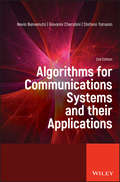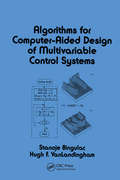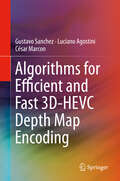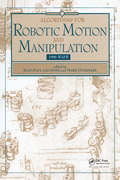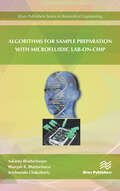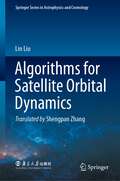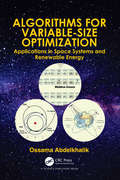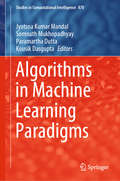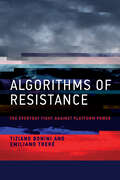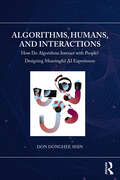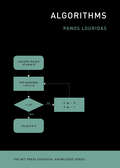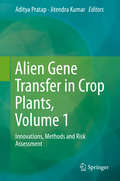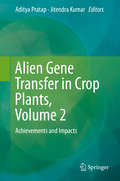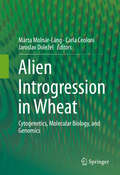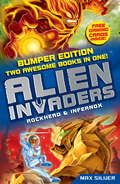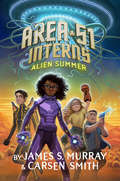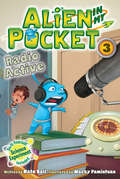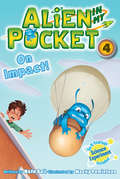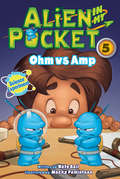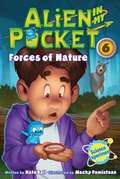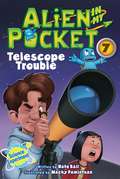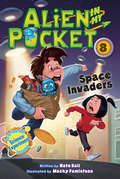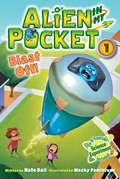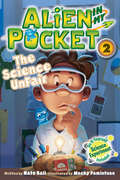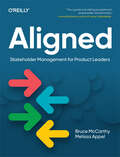- Table View
- List View
Algorithms for Communications Systems and their Applications
by Nevio Benvenuto Stefano Tomasin Giovanni CherubiniThis welcome second edition to the 2002 original presents the logical arithmetical or computational procedures within communications systems that will ensure the solution to various problems. The authors comprehensively introduce the theoretical elements which are at the basis of the field of algorithms for communications systems. Various applications of these algorithms are then illustrated with a focus on wired and wireless network access technologies. The updated applications will focus on 5G standards, and new material will include MIMO systems (Space-time block coding / Spatial multiplexing / Beamforming and interference management / Channel Estimation /mmWave Model); OFDM and SC-FDMA (Synchronization / Resource allocation (bit and power loading) / Filtered OFDM); Full Duplex Systems (Digital interference cancellation techniques).
Algorithms for Computer-Aided Design of Multivariable Control Systems (Electrical and Computer Engineering)
by Stanoje Bingulac Hugh F. VanlandinghamThis reference/text discusses the structure and concepts of multivariable control systems, offering a balanced presentation of theory, algorithm development, and methods of implementation.;The book contains a powerful software package - L.A.S (Linear Algebra and Systems) which provides a tool for verifying an analysis technique or control design.;Reviewing the fundamentals of linear algebra and system theory, Algorithms for Computer-Aided Design of Multivariable Control Systems: supplies a solid basis for understanding multivariable systems and their characteristics; highlights the most relevant mathematical developments while keeping proofs and detailed derivations to a minimum; emphasizes the use of computer algorithms; provides special sections of application problems and their solutions to enhance learning; presents a unified theory of linear multi-input, multi-output (MIMO) system models; and introduces new results based on pseudo-controllability and pseudo-observability indices, furnishing algorithms for more accurate internodel conversions.;Illustrated with figures, tables and display equations and containing many previously unpublished results, Algorithms for Computer-Aided Design of Multivariable Control Systems is a reference for electrical and electronics, mechanical and control engineers and systems analysts as well as a text for upper-level undergraduate, graduate and continuing-education courses in multivariable control.
Algorithms for Efficient and Fast 3D-HEVC Depth Map Encoding
by Luciano Agostini Gustavo Sanchez César MarconThis book describes and analyzes in detail the encoding effort and the encoding tool usage applied to 3D-HEVC depth map coding. Based on the analyzed information, the authors introduce efficient algorithms for accelerating the available encoding tools. The contributions discussed in this book include four algorithms for reducing intra-frame encoding effort and three algorithms for reducing inter-frame encoding effort. The presented results demonstrate several levels of encoding effort reduction with different impacts in the encoding efficiency, surpassing state-of-the-art solutions by more than 50% the encoding effort with only 0.3% encoding efficiency loss.
Algorithms for Robotic Motion and Manipulation: WAFR 1996
by Mark Overmars Jean-Paul LaumondThis volume deals with core problems in robotics, like motion planning, sensor-based planning, manipulation, and assembly planning. It also discusses the application of robotics algorithms in other domains, such as molecular modeling, computer graphics, and image analysis. Topics Include: - Planning - Sensor Based Motion Planning - Control and Moti
Algorithms for Sample Preparation with Microfluidic Lab-on-Chip
by Krishnendu Chakrabarty Bhargab B. Bhattacharya Sukanta BhattacharjeeRecent microfluidic technologies have brought a complete paradigm shift in automating biochemical processing on a tiny lab-on-chip (a.k.a. biochip) that replaces expensive and bulky instruments traditionally used in implementing bench-top laboratory protocols. Biochips have already made a profound impact on various application domains such as clinical diagnostics, DNA analysis, genetic engineering, and drug discovery, among others. They are capable of precisely manipulating micro-/pico-liter quantities of fluids, and provide integrated support for mixing, storage, transportation, and sensing, on-chip. In almost all bioprotocols, sample preparation plays an important role, which includes dilution and mixing of several fluids satisfying certain volumetric ratios. However, designing algorithms that minimize reactant-cost and sample-preparation time suited for microfluidic chips poses a great challenge from the perspective of protocol mapping, scheduling, and physical design. Algorithms for Sample Preparation with Microfluidic Lab-on-Chip attempts to bridge the widening gap between biologists and engineers by introducing, from the fundamentals, several state-of-the-art computer-aided-design (CAD) algorithms for sample preparation with digital and flow-based microfluidic biochips. Technical topics discussed in the book include: Basics of digital and flow-based microfluidic lab-on-chipComprehensive review of state-of-the-art sample preparation algorithmsSample-preparation algorithms for digital microfluidic lab-on-chipSample-preparation algorithms for flow-based microfluidic lab-on-chip
Algorithms for Satellite Orbital Dynamics (Springer Series in Astrophysics and Cosmology)
by Lin LiuThis book highlights the fundamental physics of orbit theory, dynamical models, methods of orbit determination, design, measurement, adjustment, and complete calculations for the position, tracking, and prediction of satellites and deep spacecraft. It emphasizes specific methods, related mathematical calculations, and worked examples and exercises. Therefore, technicians and engineers in the aerospace industry can directly apply them to their practical work. Dedicated to undergraduate students and graduate students, researchers, and professionals in astronomy, physics, space science, and related aerospace industries, the book is an integrated work based on the accumulated knowledge in satellite orbit dynamics and the author’s more than five decades of personal research and teaching experience in astronomy and aerospace dynamics.
Algorithms for Variable-Size Optimization: Applications in Space Systems and Renewable Energy
by Ossama AbdelkhalikMany systems architecture optimization problems are characterized by a variable number of optimization variables. Many classical optimization algorithms are not suitable for such problems. The book presents recently developed optimization concepts that are designed to solve such problems. These new concepts are implemented using genetic algorithms and differential evolution. The examples and applications presented show the effectiveness of the use of these new algorithms in optimizing systems architectures. The book focuses on systems architecture optimization. It covers new algorithms and its applications, besides reviewing fundamental mathematical concepts and classical optimization methods. It also provides detailed modeling of sample engineering problems. The book is suitable for graduate engineering students and engineers. The second part of the book includes numerical examples on classical optimization algorithms, which are useful for undergraduate engineering students. While focusing on the algorithms and their implementation, the applications in this book cover the space trajectory optimization problem, the optimization of earth orbiting satellites orbits, and the optimization of the wave energy converter dynamic system: architecture and control. These applications are illustrated in the starting of the book, and are used as case studies in later chapters for the optimization methods presented in the book.
Algorithms in Machine Learning Paradigms (Studies in Computational Intelligence #870)
by Paramartha Dutta Jyotsna Kumar Mandal Somnath Mukhopadhyay Kousik DasguptaThis book presents studies involving algorithms in the machine learning paradigms. It discusses a variety of learning problems with diverse applications, including prediction, concept learning, explanation-based learning, case-based (exemplar-based) learning, statistical rule-based learning, feature extraction-based learning, optimization-based learning, quantum-inspired learning, multi-criteria-based learning and hybrid intelligence-based learning.
Algorithms of Resistance: The Everyday Fight against Platform Power
by Emiliano Trere Tiziano BoniniHow global workers, influencers, and activists develop tactics of algorithmic resistance by appropriating and repurposing the same algorithms that control our lives.Algorithms are all around us, permeating more and more aspects of our daily lives. While accounts of platform power tend to come across as bleak and monolithic, Algorithms of Resistance shows how people can resist algorithms across a variety of domains. Drawing from rich ethnographic materials and perspectives from both the Global North and South, authors Tiziano Bonini and Emiliano Treré explore how people appropriate and reconfigure algorithms to pursue their objectives in three domains of everyday life: gig work, cultural industries, and politics. They reveal how forms of algorithmic agency and resistance are endemic and mundane and how the platform society is a contested battleground of contrasting forces. Bonini and Treré begin by outlining their key theoretical framework of moral economies. This framework argues that algorithms exist on a continuum. At its two extremes are two competing moral economies: the user moral economy and the platform moral economy. From here, Algorithms of Resistance chronicles the various inventive ways that individuals can work to achieve agency and resist the ubiquitous power of algorithms. Casting a wide net with a diverse range of case studies, Bonini and Treré reveal the moral imperative for all of us—from delivery drivers to artists to social movements—to resist algorithms.
Algorithms, Humans, and Interactions: How Do Algorithms Interact with People? Designing Meaningful AI Experiences
by Don Donghee ShinAmidst the rampant use of algorithmization enabled by AI, the common theme of AI systems is the human factor. Humans play an essential role in designing, developing, and operationalizing AI systems. We have a remit to ensure those systems run transparently, perform equitably, value our privacy, and effectively fulfill human needs. This book takes an interdisciplinary approach to contribute to the ongoing development of human–AI interaction with a particular focus on the "human" dimension and provides insights to improve the design of AI that could be genuinely beneficial and effectively used in society. The readers of this book will benefit by gaining insights into various perspectives about how AI has impacted people and society and how it will do so in the future, and understanding how we can design algorithm systems that are beneficial, legitimate, usable by humans, and designed considering and respecting human values. This book provides a horizontal set of guidelines and insight into how humans can be empowered by making choices about AI designs that allow them meaningful control over AI. Designing meaningful AI experiences has garnered great attention to address responsibility gaps and mitigate them by establishing conditions that enable the proper attribution of responsibility to humans. This book helps us understand the possibilities of what AI systems can do and how they can and should be integrated into our society.
Algorithms: A Beginner's Guide (The MIT Press Essential Knowledge series)
by Panos LouridasIn the tradition of Real World Algorithms: A Beginner's Guide, Panos Louridas is back to introduce algorithms in an accessible manner, utilizing various examples to explain not just what algorithms are but how they work.Digital technology runs on algorithms, sets of instructions that describe how to do something efficiently. Application areas range from search engines to tournament scheduling, DNA sequencing, and machine learning. Arguing that every educated person today needs to have some understanding of algorithms and what they do, in this volume in the MIT Press Essential Knowledge series, Panos Louridas offers an introduction to algorithms that is accessible to the nonspecialist reader. Louridas explains not just what algorithms are but also how they work, offering a wide range of examples and keeping mathematics to a minimum.
Alien Gene Transfer in Crop Plants, Volume 1: Innovations, Methods and Risk Assessment
by Aditya Pratap Jitendra KumarGenetic engineering and biotechnology along with conventional breeding have played an important role in developing superior cultivars by transferring economically important traits from distant, wild and even unrelated species to the cultivated varieties which otherwise could not have been possible with conventional breeding. There is a vast amount of literature pertaining to the genetic improvement of crops over last few decades. However, the wonderful results achieved by crop scientists in food legumes’ research and development over the years are scattered in different journals of the World. <P><P> The two volumes in the series ‘Alien Gene Transfer in Crop Plants’ address this issue and offer a comprehensive reference on the developments made in major food crops of the world. These volumes aim at bringing the contributions from globally renowned scientists at one platform in a reader-friendly manner.<P><P> The 1st volume entitled, ‘Alien Gene Transfer in Crop Plants: Innovations, Methods and Risk Assessment” will deal exclusively with the process and methodology. The contents of this volume have been designed to appraise the readers with all the theoretical and practical aspects of wide hybridization and gene transfer like processes and methods of gene transfer, role of biotechnology with special reference to embryo rescue, genetic transformation, protoplast fusion and molecular marker technology, problems such as cross incompatibility and barriers to distant hybridization and solutions to overcome them. Since wild and weedy relatives of crop plants may have negative traits associated with them, there are always possibilities of linkage drag while transferring alien alleles. Therefore, problems and limitations of alien gene transfer from these species will also be discussed in this series. Further, the associated risks with this and assessment of risks will also be given due weightage.
Alien Gene Transfer in Crop Plants, Volume 2: Achievements and Impacts
by Aditya Pratap Jitendra KumarGenetic engineering and biotechnology along with conventional breeding have played an important role in developing superior cultivars by transferring economically important traits from distant, wild and even unrelated species to the cultivated varieties which otherwise could not have been possible with conventional breeding. There is a vast amount of literature pertaining to the genetic improvement of crops over last few decades. However, the wonderful results achieved by crop scientists in food legumes’ research and development over the years are scattered in different journals of the World. <P><P> The two volumes in the series ‘Alien Gene Transfer in Crop Plants’ address this issue and offer a comprehensive reference on the developments made in major food crops of the world. These volumes aim at bringing the contributions from globally renowned scientists at one platform in a reader-friendly manner. The second volume entitled, “Alien Gene Transfer in Crop Plants: Achievements and Impact” will deal more with the practical aspects. This volume will cover achievements of alien gene transfer in major food crops of the world and their impact on development of newer genetic variability and additional avenues for selection; development of superior cultivars for increased yield, resistance to biotic and abiotic stresses, improved nutritional and industrial quality; innovation of new techniques and positive as well as negative environmental implications. This volume has been divided into four groups with an aim to cover all major cereals, pulses, oilseeds and other crops (vegetable and horticultural crops) which are of economic importance.
Alien Introgression in Wheat: Cytogenetics, Molecular Biology, and Genomics
by Márta Molnár-Láng Carla Ceoloni Jaroslav DoleželThis book provides an overview of the latest advancements in the field of alien introgression in wheat. The discovery and wide application of molecular genetic techniques including molecular markers, in situ hybridization, and genomics has led to a surge in interspecific and intergeneric hybridization in recent decades. The work begins with the taxonomy of cereals, especially of those species which are potential gene sources for wheat improvement. The text then goes on to cover the origin of wheat, breeding in connection with alien introgressions, and the problems of producing intergeneric hybrids and backcross derivatives. These problems can include crossability, sterility, and unequal chromosome transmission. The work then covers alien introgressions according to the related species used, as well as new results in the field of genomics of wild wheat relatives and introgressions.
Alien Invaders (2 Books in 1): Two Book Bind-up
by Max SilverDiscover the explosive world of Alien Invaders in this awesome introduction to the series - featuring Cosmo's first two adventures in full! Travel at hyperspeed to the moon of Garr where you will battle the first invader ROCKHEAD, the living mountain. Then, fly your own Dragster 7000 spaceship to the jungle planet of Zaman, where you will battle the second invader INFERNOX, the firestarter!Complete with bonus games and puzzles - and fantastic gaming cards that allow you to do battle alongside Cosmo!
Alien Summer #1 (Area 51 Interns)
by James S. Murray Carsen Smith"An exciting series opener."—Kirkus From the mind of Murr from the Impractical Jokers comes a new hilarious, action-packed series about a world of bizarre creatures, wacky gadgets, and four kid interns at the most interesting place on Earth: Area 51!It's the first day of summer vacation, and Viv Harlow just wants to relax with her friends at the beach before they all go to different high schools next year. She is definitely not interested in visiting her mom's office, even if Director Harlow works at the famous Area 51. But when an alarm sounds beneath the secret base and a whole race of aliens escape, she's about to get much more than she bargained for. Viv, Charlotte, Ray, and Elijah (who Viv is totally NOT crushing on) will have to work together, gear up with gadgets, and even protect a baby alien to save the day and defend Area 51.The debut middle-grade series from Murr of the Impractical Jokers, Area 51 Interns is filled with enough high-tech hijinks, bizarre creatures, and laugh-out-loud humor (plus an extra color insert full of gadgets) to make even alien skeptics hooked for more!
Alien in My Pocket #3: Radio Active
by Macky Pamintuan Nate BallThis third book in the Alien in My Pocket series is the zaniest yet! Zack and Amp create a massive mishap in this hilarious story. Plus the book comes with a do-it-yourself science experiment.Nothing's been easy since Amp crash-landed his spaceship through Zack McGee's bedroom window. Now Amp has built a quantum radio to alert his commanders to call off the invasion of Earth. Unfortunately, instead of contacting Erdian Central Command, Amp's radio accidentally broadcasts Amp's messages all over Zack's hometown. Now it's up to Zack and his best friend, Olivia, to save their alien friend from being discovered and to save the planet from panic.With illustrations throughout, a page-turning plot, and fun scientific facts, this is the perfect chapter book for young readers. Supports the Common Core State Standards.
Alien in My Pocket #4: On Impact!
by Macky Pamintuan Nate BallThis must-read Alien in My Pocket book is the fourth in the series by Nate Ball, the host of PBS's Design Squad and Design Squad Nation. In this hilarious new adventure, Zack and his alien friend, Amp, learn about friction, deceleration, and how to soften a crash-landing.When Zack McGee crashes his bike, he's stuck at home with his arm in a sling and his baseball season on the line. What's worse, his bike crashed because his four-inch-tall houseguest, Amp, experimented on the brakes! Now Zack is easy prey for his little brother, Taylor, who's determined to find out once and for all what mysteries Zack has hidden in his pocket.Like every book in the Alien in My Pocket series, On Impact! mixes Common Core-aligned science and safe, hands-on experiments with a hilarious story that young readers will love.Publishers Weekly said of Alien in My Pocket: Blast Off!: "With its screwball comedy and lively dialogue, the novel gives readers the opportunity to laugh as they learn."Supports the Common Core State Standards
Alien in My Pocket #5: Ohm vs. Amp
by Macky Pamintuan Nate BallZack and Amp get a serious surprise in the fifth installment of this intergalactic chapter book series by Nate Ball, the host of PBS's Design Squad and Design Squad Nation. Zack and his alien friend, Amp, discover that leverage can be an Earth-saving thing when they build a rocket-launching atlatl!Zack McGee's life has been filled with trouble since Amp, a four-inch-tall alien scout, crash-landed into Zack's bedroom. But now it's Amp's turn to be in the hot seat. When his commander, Ohm, arrives to take Amp back home, the aliens feud. Amp has to get his cranky counterpart off Earth before they all end up in a world of trouble!Like every book in the Alien in My Pocket series, Ohm vs. Amp mixes Common Core-aligned science, and safe, hands-on experiments with a hilarious story that young readers will love.Publishers Weekly said of Alien in My Pocket: Blast Off!: "With its screwball comedy and lively dialogue, the novel gives readers the opportunity to laugh as they learn."Correlates to the Common Core State Standards in English Language Arts
Alien in My Pocket #6: Forces of Nature
by Macky Pamintuan Nate BallZack and Amp get a serious surprise in Forces of Nature, the sixth installment of this fun intergalactic chapter book series by Nate Ball, the host of PBS's Design Squad and Design Squad Nation.Ever since Amp crash-landed his spaceship through Zack McGee's window, Zack's life has gone in some unexpected directions. But when everything goes wrong on the McGee family camping trip, Zack's going to need Amp's alien scouting skills to navigate the great outdoors and find their way back to civilization!Like every book in the Alien in My Pocket series, Forces of Nature mixes Common Core-aligned science with safe, hands-on experiments that young readers will love. This installment includes a build-your-own compass experiment.Publishers Weekly said of Alien in My Pocket: Blast Off!: "With its screwball comedy and lively dialogue, the novel gives readers the opportunity to laugh as they learn."
Alien in My Pocket #7: Telescope Troubles
by Macky Pamintuan Nate BallIt's Zack and Amp to the rescue in the seventh book in Nate Ball's beloved Alien in My Pocket series! With a tale that's sure to tickle the funny bone and a do-it-yourself hover-ship science experiment, it's an adventure readers are sure to enjoy.<P><P>Life has been no picnic since Amp crash-landed his spaceship through Zack McGee's window. But when Amp takes up stargazing, he makes a huge discovery that will take their zany adventures to the next level. It appears that the Erdian aliens are at it again! The alien invasion of Earth is in progress, and it's up to Zack, Amp, and Olivia to leap into action. But this time it'll take more than a little gadgetry and a few white lies to get Amp out of trouble and to save the world!Like every book in the Alien in My Pocket series, Telescope Troubles mixes Common Core-aligned science and safe, hands-on experiments with a hilarious story that young readers will love. Publishers Weekly said of Alien in My Pocket: Blast Off!: "With its screwball comedy and lively dialogue, the novel gives readers the opportunity to laugh as they learn."Correlates to the Common Core State Standards in the English Language Arts
Alien in My Pocket #8: Space Invaders
by Macky Pamintuan Nate BallIt's the thrilling conclusion to the Alien in My Pocket series! With a page-turning plot, plenty of fun science facts, illustrations throughout, and a do-it-yourself, hands-on experiment at the end, this is an appealing chapter book series for young readers. And it's all from the amazing brain of MIT graduate Nate Ball, host of PBS's Emmy Award-winning Design Squad series.Zack has grown fond of his troublesome buddy, Amp, since the four-inch-tall alien crash-landed his spaceship through Zack's bedroom window. They've gotten into more than their fair share of trouble together, but they've always invented a way out of it. Until a fleet of ships from Amp's home planet filled the sky and started firing its weapons. Zack and Amp have to do the thing most kids only dare imagine--save the world!Correlates to the Common Core State Standards in English Language Arts
Alien in My Pocket: Blast Off!
by Macky Pamintuan Nate BallThe adventure begins in this exciting new chapter book series, complete with a do-it-yourself science experiment! When a four-inch-tall alien crash-lands through Zack McGee's bedroom window, Zack is sure he's about to become the first victim in a new War of the Worlds. But when the alien turns out to have weapons that are more ticklish than terrifying, Zack realizes that rather than protect the world from the alien it's up to him to protect the alien in his pocket from the world.With illustrations on every spread, a how-to on launching a rocket, fun scientific facts, and the hilarious adventures of Zack and Amp, this book is the perfect gift for any young reader!Supports the Common Core State Standards
Alien in My Pocket: The Science UnFair
by Macky Pamintuan Nate BallThe must-read second book in the Alien in My Pocket series. Zack and Amp are back and up to even more trouble in this hilarious story, complete with a do-it-yourself science experiment!Ever since Amp crash-landed his spaceship through Zack McGee's bedroom window, Zack's life has gotten crazier and his grades have gone from bad to worse. Who has time for homework when there's an alien invasion to stop? But now Zack's up against his greatest challenge yet--the school science fair. If Zack doesn't get an A on his project, he's going to flunk the class. Luckily, Zack has Amp around to help, but when Zack's experiment turns out to be too good, he winds up in a whole different kind of trouble.Complete with many illustrations, a riveting plot, and fun scientific facts, this book is perfect for young readers!Supports the Common Core State Standards
Aligned: Stakeholder Management for Product Leaders
by Bruce McCarthy Melissa AppelProduct management naturally incorporates empathy, psychology, and thinking outside the box in pursuit of the best design for products. But how often do you apply those same skills to your relationships with people in your company?By breaking the art of stakeholder management into simple lessons and frameworks, this practical book shows product managers how to manage the crucial relationships that will help you make an impact and advance your career. You'll learn how to build trusting relationships with stakeholders, optimize your communication for different audiences, get buy-in for your ideas and roadmaps, and have stakeholders appreciate it when you say no.You'll learn how to:Build and maintain trust with your stakeholdersMap your organization and identify the real power playersEstablish roles and build an extended team that works well togetherCommunicate in a way that speaks to the needs and goals of different stakeholdersGet buy-in on your ideas and roadmapMake stakeholders appreciate and support you when you say "no"Sustain buy-in over timeManage difficult stakeholders and personalities
